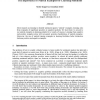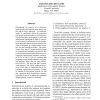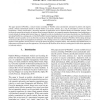24 search results - page 3 / 5 » Sentiment Classification and Polarity Shifting |
CI
2006
13 years 7 months ago
2006
Most research on learning to identify sentiment ignores "neutral" examples, learning only from examples of significant (positive or negative) polarity. We show that it i...
EMNLP
2008
13 years 8 months ago
2008
Determining the polarity of a sentimentbearing expression requires more than a simple bag-of-words approach. In particular, words or constituents within the expression can interac...
IRCDL
2008
13 years 8 months ago
2008
Several sites allow users to publish personal reviews about products and services available on the market. In this paper, we consider the problem of applying classification techniq...
LREC
2010
13 years 8 months ago
2010
This paper presents Q-WordNet, a lexical resource consisting of WordNet senses automatically annotated by positive and negative polarity. Polarity classification amounts to decide...
ACL
2004
13 years 8 months ago
2004
Sentiment classification is the task of labeling a review document according to the polarity of its prevailing opinion (favorable or unfavorable). In approaching this problem, a m...



